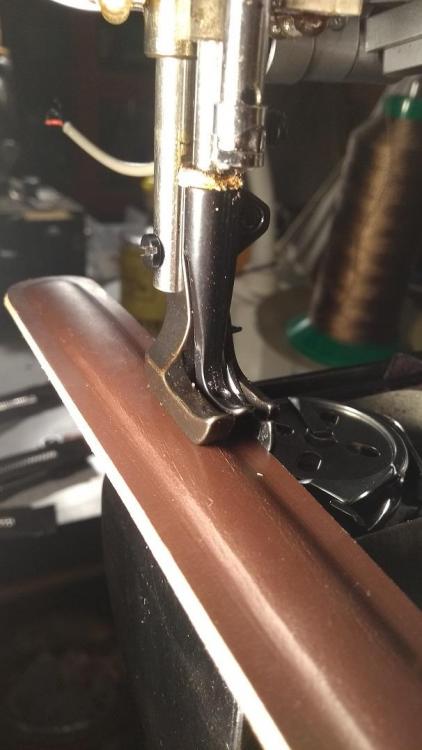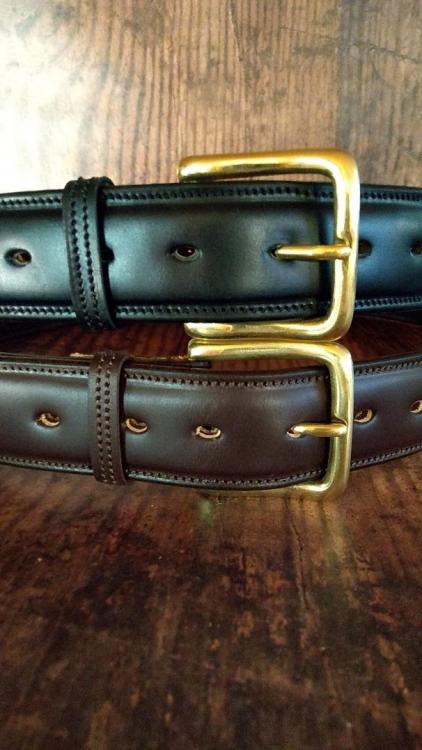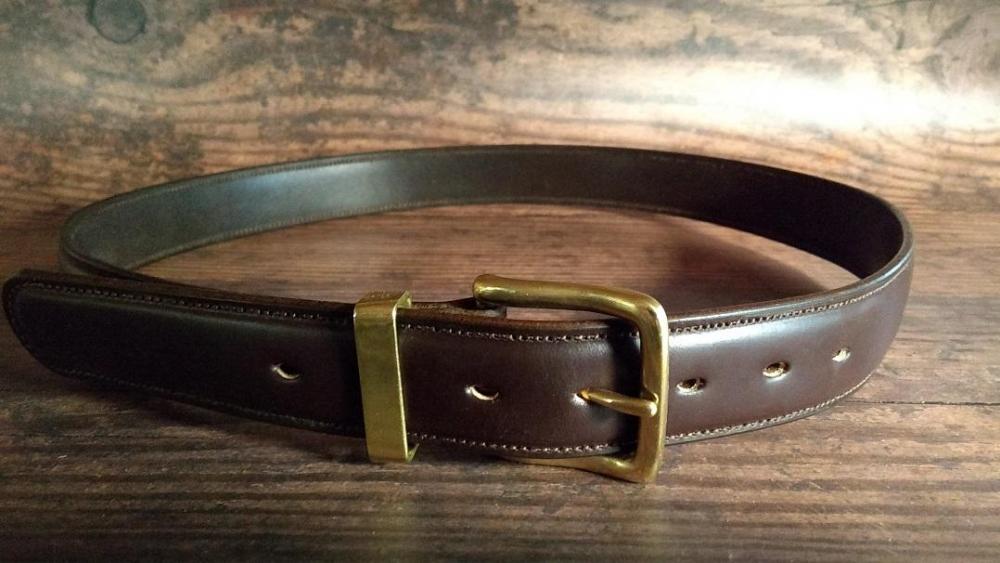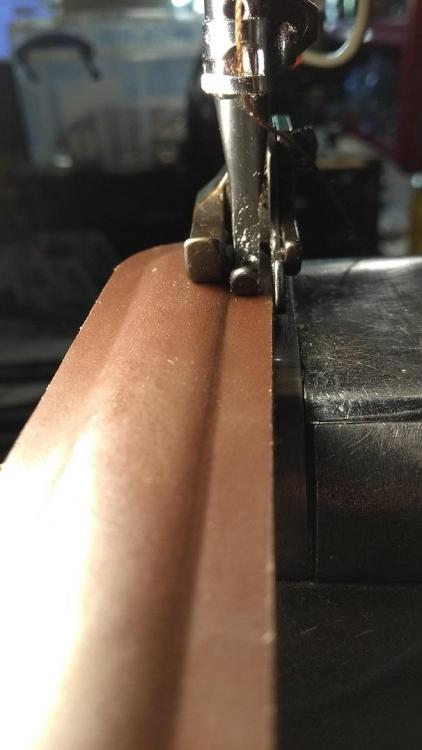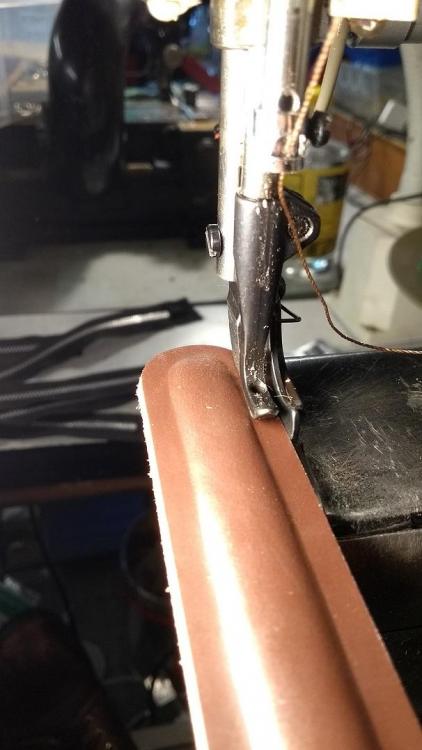-
Posts
1,806 -
Joined
Content Type
Profiles
Forums
Events
Blogs
Gallery
Everything posted by Matt S
-

Pfaff 335 clone sold as a genuine Pfaff
Matt S replied to vanessaFrance's topic in Leather Sewing Machines
Making it obvious that a person's conduct is being recorded (or implying that it is, even when not) is often believed to improve their conduct. Further, as I said previously, use of a recording for commercial purposes is a different kettle of fish. Filming someone's kids without an obvious reason why will cause police intervention/investigation because there is a prima face case of filming with criminal intent. Under UK law there is no and never has been any presumption of privacy in a public place (which can and does include business premises and other private property). This is very well established. Similarly, covert/concealed (as opposed to overt) CCTV cameras, private or public, are perfectly legal to operate anywhere, except where privacy is reasonably expected, such as a changing room or toilet. I don't agree with your interpretation of the law at all, especially the automatic supremacy of EU law over Westminster statute, but you are free to do so and I think that we are drifting rather far from the topic of this thread. I live and work under the interpretation of the law that the Metropolitan Police and Crown Prosecution Service use -- as do the many people I know who operate recording devices within the UK for hobby and business purposes. -
Your vintage car club sounds a lot like a target-shooting club. I know of one chap who has a very extensive and valuable collection of Lee Enfields. ("Nice L42" "Thanks, this is the shoddy one, the nice three don't leave the safe" etc.) His wet-weather gear is a set of dayglo overalls a tarmac gang threw away as too disreputable. I find that particularly affluent persons can be some of the most penny-pinching of all. (My granda would say "tighter than a duck's arse", but I'm no so indelicate.) After all -- they didn't get rich by spending money!
-
I find that's SOP for most leather machines ;-) I'm sure that most have a scrap-detector hidden somewhere in the castings... My bell-skiver is a rather old/worn in, and it's the only one I've put any decent amount of miles on so my experience is rather limited. Take that as you will. I'm sure that more widely experienced operators will be along in due course. I know that @RockyAussie has a lot of experience with them. Things to check for as you're running the machine, in no particular order, I have found might cause or contribute to this issue: Scrap buildup on and around the knife and feedwheel Incorrect setting of the feedwheel pressure spring (too light or heavy -- experiment) Inconsistent feedwheel height or angle (binding of the joint, scrap/detritus buildup under the assembly or screw walkout due to not being locked down) Incorrect or inconsistent presser foot pressure (are you returning the lifter fully to the stop position each time?) Slop or other undesired movement in any part of the presser foot assembly (remembering to check any moving parts you may have in your presser foot) Inconsistent knife edge position for any reason (slop in the bearing, loose adjustment screw, heavy grinding etc.) I was shown a lot of tips and tricks from the old boy from whom I bought my machine, but have found a lot of wisdom in Checaflo's videos on skiving machines. He looks primarily from a car upholsterer's PoV but most of the information is useful to most trades that use a bell-skiver, and I think they're all interesting.
-

Pfaff 335 clone sold as a genuine Pfaff
Matt S replied to vanessaFrance's topic in Leather Sewing Machines
That is not my understanding of the law, certainly within the UK. Except when doing so for criminal purposes there is no bar from recording audio, stills or video, with or without the permission of the other party/parties involved. Making money from said recording is a slightly murkier part of law, but is in any case a civil matter rather than criminal. -
Ranger. Primarily for cutting shoe soling. I tried one once, it left little serrated marks on the leather.
-
I wonder if there's some markings on the bottom of the main casting.
-
Left to right is a de facto industry standard.
-
I was thinking of a Bauer, but now I see the lower casting is quite different and the wheel is in the wrong place. Almost reminds me of a Dohle 715, but again not. It's a riddle wrapped in an enigma wrapped in cast iron. Do we know for certain if it's a lock-stitch or chain-stitch?
-
It does ring a bell with an obscure harness machine, but I can't recall what it was. I wonder if @Big Sioux Saddlery might recognise it?
-

Best Sewing Machines- New vs Used/Antique
Matt S replied to jrprottas's topic in Leather Sewing Machines
I've never seen one in the flesh (they're not generally available over here) but I would hesitate to call anything Sailrite a top leather machine. I'm sure they're fine for relatively heavy fabrics though. I should also mention that Cowboy, Cobra and Techsew are brands of clone and derivative machines out of China. I'm not knocking them on that, but they're generally considered to be lower quality than Juki, Adler, Seiko etc. In a factory setting (8+ hours a day, full-speed) they wear and break a lot faster. For hobbyists and small-production facilities (as typifies the majority of members on this forum) they are more than adequate and represent a better value-for-money than a new Adler, Seiko or Juki at 2-3 times the same price for a comparable setup. In a word:, yes. In more words: yes, unless you're lucky enough to find a used machine being sold below its value and willing to spend sweat equity acquiring, cleaning, servicing and adjusting it to meet your needs. Plus $ on parts and professional help for the things you can't do. BTW $5K isn't the top end, by a long margin... No. It's literally a minute to do, which you roll into the daily or twice-daily clean, check and needle replacement that you will need to do anyway. If you're not running the machine full-bore for 8 hours a day you can often get away with not oiling daily, but I don't think it's a good habit to be in. Wiz has already pointed out that domestic machines are entirely unsuited to your purposes. Most of the Singers you're seeing are very likely domestics, irrespective of how they're being advertised. Singer stopped making industrial machines in the 1960s, though they were selling rebadged industrial Seikos and Adlers until some point in the 80s I think. 50+ year old industrial machines can be fun to play with but often lack features that are absolutely standard these days like reverse, safety clutches, compound feed, safety guards, needle positioner compatibility, semi-auto oilers, large bobbins. There are also often issues with availability of parts, bobbins and needles; wear; rust; parts cannibalisation; outright abuse. If a seller describes something as "semi-industrial" they're either being misleading or have been mislead. Less generous expressions of the same sentiment are available and no less pertinent. I don't know about your side of the pond but our vestigial manufacturing sector spits out used Adlers and Seikos on a fairly frequent basis. A lot of these models are still in production but it's important to remember that these machines have had a hard life and there's a reason why factories go through the expense and disruption of replacing their machines. I've found the best recipe for success is to find a factory that's closing down production lines rather than replacing shagged-out machines but there's still no free lunches. If I were to charge myself for the time I've spent fannying about with machines instead of actually manufacturing stuff on them I'd probably find that I would have been better off buying new machines and be done with it. But then, I'm under-capitalised and like playing about with machinery so... In the US you have access to some excellent dealers, who sell great VFM machines that they stand behind. The cost is the cost, be grateful that you're not over here, where at best you'll find low-to-mid-level machines for sale at the same or higher number of £ that you guys would pay in $. Plus 20% tax. -

Overwhelmed by leather Sewing machines
Matt S replied to Starwind0's topic in Leather Sewing Machines
No matter what machine you choose, I think you're going to struggle using v415 thread on wallets and watch bands. Machines simply can't sew thin stuff with thick threads. Big threads need about 4 thread diameters of thickness to hide the knot inside the work. -

Is there a cheaper alternative to a bell knife skiver?
Matt S replied to williaty's topic in Leather Machinery
Research them generally? There's some good videos on YouTube, especially by Checaflo. It you're looking for one cheap, trawl ebay, Craigslist, FB all the usual local ads. Get the word out there with people who might hear that someone else is selling a skiving machine. Leather dealers, other leather worries etc. -
Well that makes sense. Best of luck with your search. I don't think it's one of the more popular clone brands. What is probably most important for the beginning hobbyist is the quality of the dealer they buy it from -- is the machine checked and times, will they show you some basic operating and maintenance procedures, will they stand behind their product if the machine breaks.
-
Looks like a Chinese company that clones the more popular modern Pfaff models. Out of interest why are you looking at it, rather than your local industrial machine dealer?
-
All leather stretches. The pertinent questions are "how much will this stretch" and "how much is too much". You've already increased the thickness, which will help some. In addition to Northmount's wisdom I'll question the quality of the straps you're getting from Tandy. Supposedly, modern cattle husbandry often results in a "stretchier" hide than a century ago (something to do with fattening rates and such). Not a great deal we can do about that, though I know of a couple tanneries who select against too much stretch -- I expect that whichever tanneries supply Tandy do not. Generally, cow hides are stretchier acrossways (perpendicular to the spine) than lengthways (parallel to the spine). That's why I cut belts asking backs, butts or sides rather than across shoulders. Shoulders are cheaper but you get shorter, stretchier straps. That's fine for some things but not the way I do belts. Check that Tandy isn't cutting these straps from shoulders, if such a detail is listed in the description of their goods. (If the length is over 48" that's a pretty good sign they're not from shoulders.) Also, leather cut from near the spine is less stretchy than leather cut from near the belly. Again it may not make a difference in some applications, and in fact it might be advantageous to use belly leather for some jobs. However for something where you want to minimise stretch you want something from high up in the back and I bet that Tandy doesn't grade for this so you might have got four straps from low down on the beast(s). This could especially be the case if your order is being fulfilled from a store where previous customers may have picked through for the least stretchy ones or if you bought from a store without checking them for indications of stretchiness yourself. If you want absolute minimal stretch you can glue and sew two layers of leather together with something non-stretchy in between, like fibreglass tape or webbing but I think that's a little overkill. Once you know how much stretch you can expect, maybe that's something to build into the design.
-
Price drop to £250.
-
That's an interesting find, I'll file it away under "will be useful one day". As you say it'd be hard to do the ends with a full width hollow in the foot. With a half width hollow and an edge guide on the right of the needle it might work though. Where? On the final belts it's about 9SPI, which is fine. It's a trouser belt not a harness trace -- so long as the holes aren't postage stamping the leather it's a purely a matter of taste. This is TKT20/V138 thread, much above 7SPI it starts looking like a racing stitch. On the first attempts yes the stitch length was too short. Partly due to the feet not feeding the leather too well and partly cos I hadn't increased stitch length setting to compensate for the extra thickness (pendulum needle motion).
-
I'll give it a try but the piping feet I have wouldn't be a good fit for the shape of these belts.
-

How To Run A 3 Phase 380V Motor On 220V
Matt S replied to Constabulary's topic in Leather Sewing Machines
I had the same thought when I bought a 3-phase splitter. Turns out those magic boxes release the magic smoke if any switchgear between the motor and the controller changes state while it's running. They also need to be tuned to the load and aren't really recommended for running multiple motors. My machine has 4 motors, all different RPMs and power requirements. I left the electrogubbins in the control cabinet alone and just built a static converter. -
Several other lopsided outer feet were tried, to similar effect. I tried a blanket inner foot but it tore up the bridle leather too much. I was considering grinding a spare double-toe outer foot so the left toe was 2mm higher than the right, or even slipping one of the presser bars up or down. Then it hit me. This machine uses the common 111-style feet. These have the inner foot held onto the presser bar with a screw tightened split collar but positively positioned with a small ridge on the bar. A quick experiment with the foot installed 2mm too low on the bar showed I was onto something but I didn't trust the foot not to slip up the bar in use. So I cut a piece of scrap split into small washer that was a snug fit on the inner foot presser bar. Boom. Perfect fit and function, even turning round the ends. All the weird symptoms disappeared and now all I have to worry about is user error. That'll do.
-
Don't know if this is of interest to anyone but I reckon some people might encounter this problem or something similar. Recently I decided I wanted to teach myself how to make raised-panel belts. So I did. The most confusing issue I came across I'd never expected nor heard of: my W/F machine (Seiko LCW-8BL) was throwing a fit. Tension wouldn't balance; thread jams; uneven feed; unenevn stitch length. Re-threaded, wound a new bobbin, tried needle sizes up and down, tried a smaller bobbin thread, even checked the timing. Couldn't finger it quite out. Then I realised that the way I was sewing, the inner foot was bottoming out 2mm lower than the outer. Here we have a clear shot of the issue: The raised panel is around 6mm thick, and the lower rim about 4mm. First attempt was to use one of my "delicately modified" outer feet, which have had the left toe amputated with the 40grit sparkmaker. This looked like it should work and indeed worked okay on the straight, but the marginal contact by the outer foot went down to about zero as soon as I started turning the ends of the piece.
-
Glue and stitch back-to-back to make low-cost "rough out" belts? Maybe not good enough for Wild Harry but if you could produce them fast enough they'd be plenty strong enough for a lower-price leather belt.
-
AA Crack, leather wholesaler in Northampton, England, carry buttero. They will sell as little as a single piece. We're still in the EU (for now) so you shouldn't pay import tax (but you will pay VAT, as you would buying from any company within the EU unless you're registered). If you want to set yourself up as a dealer knock yourself out and best of luck to you. If you're just trying to provide a semi-altruistic service to fellow leather-crafters, you can save yourself a lot of aggro by just buying it from an existing dealer. Tanneries often have large minimum order quantities, or flat out don't deal with the general public.
- 4 replies
-
- buttero
- crowdfunding
-
(and 1 more)
Tagged with:
-
Yes, if you have a better way of making a crease than heating the tool please share.
-
It works better than cold.



